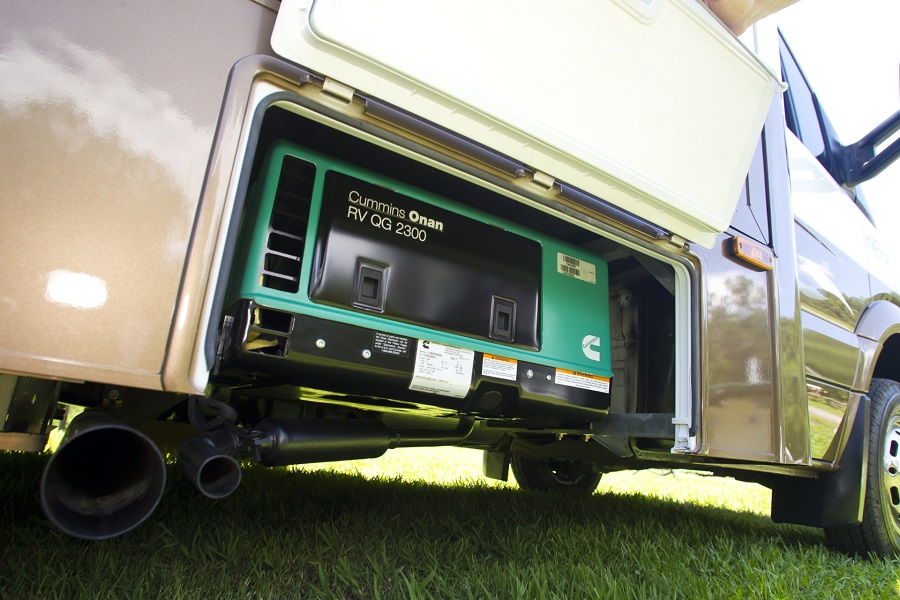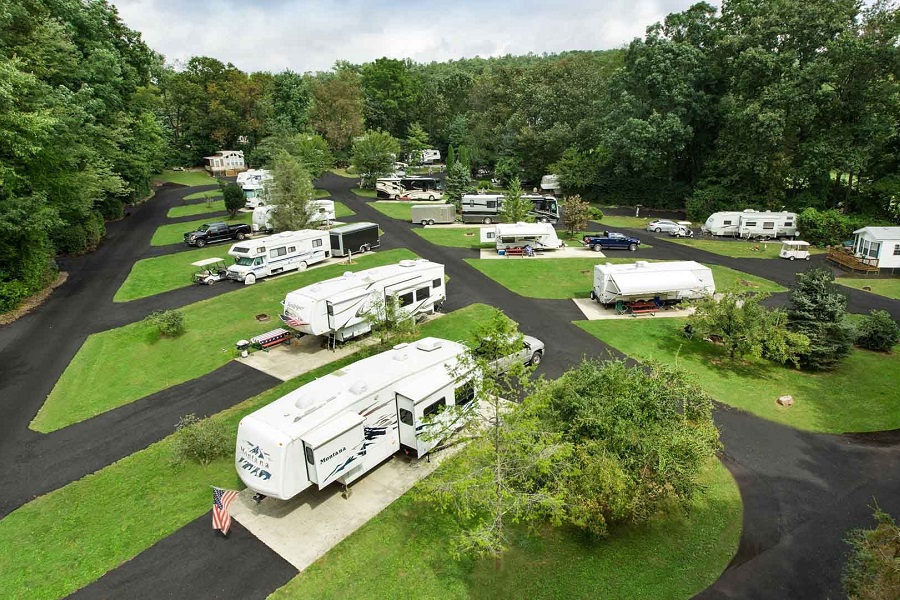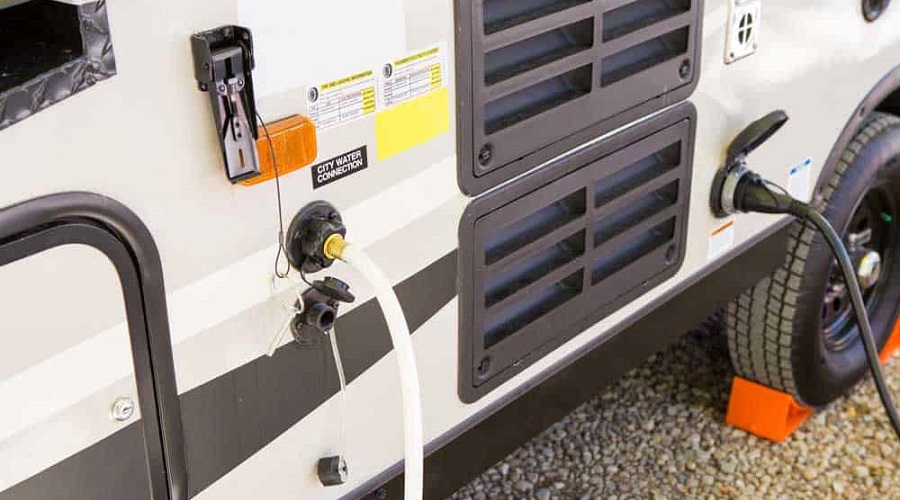Owning an RV isn’t all fun road trips and long vacations in your personal moving home, there’s a lot of ongoing care and maintenance that comes with it too.
Most of the work we do on our RVs is all about prevention rather than treating a problem when it gets out of control, and cleaning its roof is one of them.
How do you clean an RV roof?
The best method for cleaning will depend on the material your RV’s roof is made of; usually synthetic rubber or fiberglass.
The best approach for either is a gentle soap that will clean it without being abrasive and then followed up with a further treatment to prevent oxidization and damage.
A responsible RV owner already knows the importance of keeping their motorhome in good condition, especially when it comes to the roof.
If you want to know more about cleaning RV rooftops and why it matters, this essential guide covers it all and shows you the easiest way to get the job done.
Why Should You Clean Your RV’s Roof?
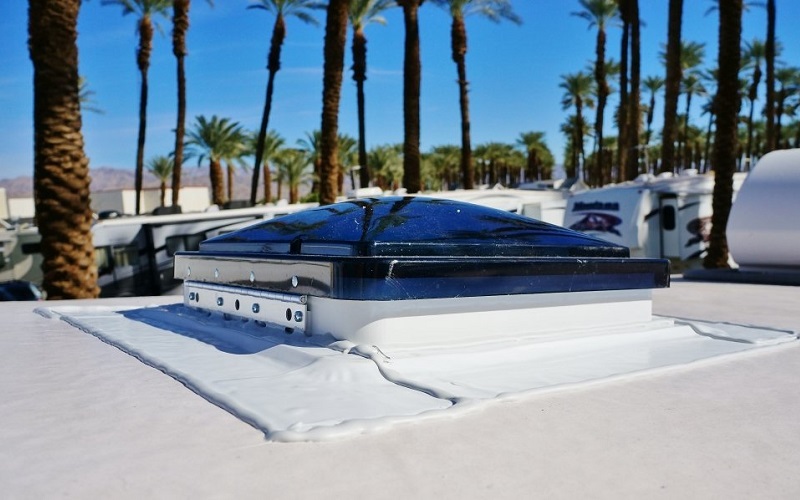
Cleaning your RV isn’t always the most glamorous job, but it’s a necessity. The roof is a part that’s easy to overlook because you can’t see it at first glance but as it’s one of the most exposed to the sun and other harsh elements, it should be given top priority.
Keeping your entire RV clean, including the roof, is essential for keeping the value of the vehicle and it should be done regularly.
When you consider how much we invest into our vehicles and the likelihood that someday we’ll want to upgrade and sell the one we already own, you want to do everything you can to hold its value.
The roof of an RV is particularly prone to damage like oxidization as it receives direct sunlight when you’re on the road driving or have it parked.
A roof with this type of damage can create cracks and splits which let water in, damaging the ceiling, walls, interior, and electrical components of your RV, leaving you with a lot to repair.
Worse still, your health could be a risk from mold and mildew that develop due to these damp conditions.
The Different Types Of RV roof
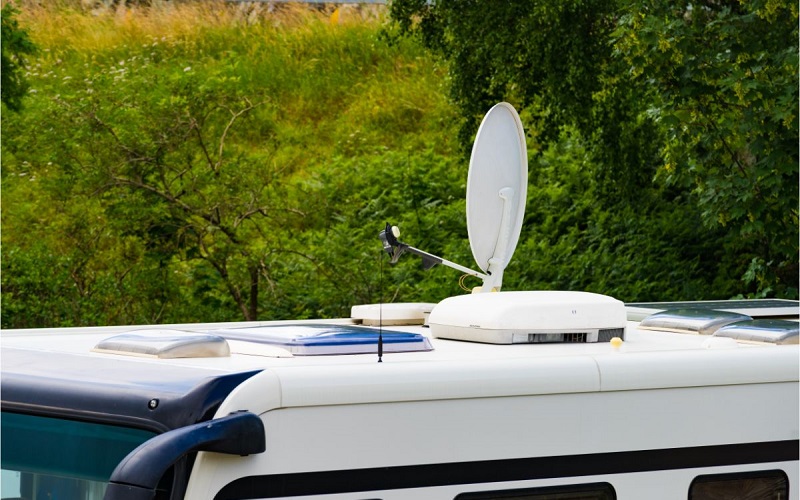
All RVs are made different, and this includes their roofs, so to make sure you’re keeping them in top shape, you need to know the basics. These are the most common types of RV roof found today and a bit about the unique care that they need.
Rubber EPDM Roof
EPDM is ethylene propylene diene monomer, and this is a membrane rubber that’s stretched out over RVs that have a flat roof.
This is the cheapest option of all but also the least visually appealing, as the end result looks stretched out which can lead to cracks.
Cleaning this type of roof is easy as is repairing the cracks, but you will likely do it more often.
An EPDM roof is also more prone to absorbing heat which you’ll feel in the RV.
Rubber TPO Roof
TPO or thermoplastic polyolefin is a single-ply rubber regarded as one of the cheaperoptions for RV roofs and one with good reflectivity, but the shortest in terms of longevity.
It’s more common for cracks to occur on these roofs so they should be covered with laminate and washed and treated regularly, as well as stored in the shade.
Cleaning a TPO roof is relatively easy and the same as an EPDM one which makes it a popular choice.
Fiberglass Roof
A fiberglass RV roof is a common find for people who prefer not to utilize rubber.
Fiberglass is a type of reinforced plastic that’s been mixed with glass and resin, resulting in a durable and rot, fire, and rust-resistant product.
However, it’s not resistant to heat and it’s expensive to repair if anything goes wrong.
Cleaning a fiberglass roof requires extra care and additional products, so this part of its maintenance can be a hindrance.
Aluminum Roof
This is the least common type of RV roof in modern vehicles but still found on some older ones.
Aluminum used to be preferred for its longevity and durability but it has some downsides, like a lack of heat resistance and reputation as being difficult to repair.
For cleaning, it requires some gentle soap and a bit of elbow grease and is usually less sensitive to damage than others.
Step by Step Guide To Keeping It Clean
As the most popular RV roof material, we’re going to walk you through the steps needed to clean a rubber one.
These roofs are durable but still require a careful touch and the right chemicals, so see the best way to get it done.
- Inspect the rooftop of your RV, taking special care to look at all of the roof fixtures and areas around them. Look at the caulking to find cracks and make a note of what needs to be repaired or replaced.
- Determine how you’ll be washing it and with what tools. The safest approach is to clean from a ladder using a long mop or brush, but if you plan on getting on top of the roof to clean, you should be mindful of vents and slippery surfaces.
- Use a dustpan brush to sweet the roof off and get rid of any debris before you start cleaning. Even just a small amount of dirt or debris can be rubbed into the RV while you wash it, so you want it to be clean.
- Hose down the front and sides of the RV before you begin, and keep them wet throughout the process. This ensures no streaks are running down from the roof while you clean. Rinse off the roof so it’s wet before you start.
- Make a mixture of your chosen cleaner and warm water, and grab a soft scrubbing brush. Avoid anything with petroleum distillate or citrus, and don’t use household detergents. An oil-based soap is good for rubber roofs and won’t be abrasive.
- Focus on a small area at a time and use a circular motion to clean the roof. When you’re done with that part, rinse it off with water and move on. Once the whole job is done, give the roof a thorough rinse until the water is running down clear. Otherwise, your RV will be prone to buildup and further cracking with sun exposure.
- When you’re done with the entire surface, squeegee the excess water off and allow it to dry. Once dry, you can apply a protective coating if needed. For a rubber roof, this would be like a liquid rubber protectant, and for fiberglass a UV protectant designed for this material.
Ongoing Care And Maintenance
Establishing a cleaning and care schedule is a must-have for any vehicle, but especially such a huge and important investment like an RV.
Good care starts at the top so you needto commit to washing the roof of your RV, along with the rest of the vehicle, at least once a month when it’s in use.
Storage is important and will protect the roof of the vehicle and its other exposed parts, so always keep it in a secured garage when not on the road.
When you are out and about, parking it somewhere in the shade and with as much protection as possible is imperative. Investing in a portable shade cloth or other cover is a wise idea for any RV.
As well as washing and covering your car, you should be applying a UV protectant when the job is done. Depending on the type of roof your RV has, you’ll also have to determine what type of protection is best.
Most rubber roofs don’t need any added protectant but you’ll significantly extend the life of them by applying some. For a fiberglass roof, applying a UV protectant made for this material specifically is an absolute necessity to keep it in good condition.
Extra Tips For Cleaning Your RV’s Roof
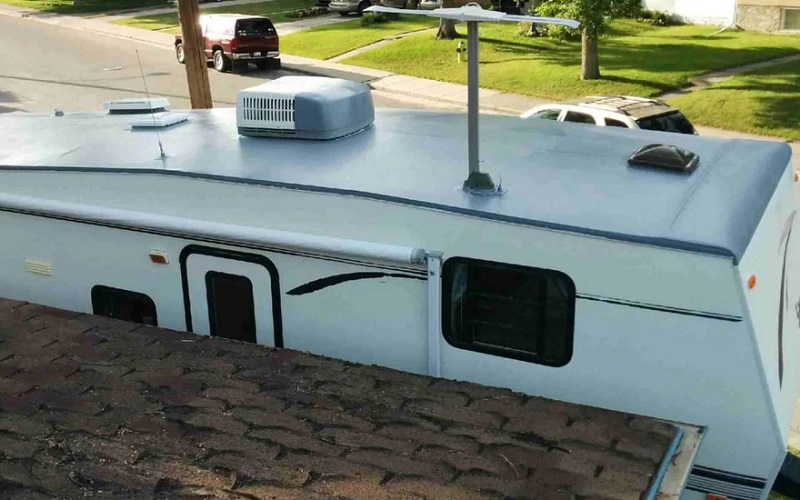
Giving your RV the correct care is the best thing you can do to protect your investment and prevent damage in the future.
We’ve got some simple tips you can do to keep the roof of your RV in top shape so that the rest of the vehicle can benefit.
- Invest in a few tools that make it easy to clean your RV and take them with you when you travel. A portable pressure washer, long-handled broom or mop, and the right type of cleaner and the three most important elements.
- Research how to make quick fixes to your RV roof if you happen to spot a crack or damaged part. Once you’re back in civilization, you can call in the professionals, but you should be able to fix these yourself in a pinch.
- A quality roof lap sealant should be applied regularly to fill in any minor cracks and prevent further damage from occurring. Choose one that’s made for the material of your RV roof specifically.
- Know the capabilities of your RV roof and make sure it’s replaced as required. Leaving a roof on longer than it’s capable of being effective for will only result in damage to the rest of the vehicle.
- Use a spotter when you’re cleaning the RV or roof as it can be a dangerous job. Working this high is risky in itself but when you add in soap and water it’s even more hazardous.
A Cared For RV Starts At The Top
Any RV owner considers their camper to be their pride and joy, and they will do whatever they can to take care of it.
By inspecting your RV from top to toe on a regular basis and giving the entire vehicle a quick clean now and then, you’ll ensure you hold its value for years to come and prevent any unnecessary damage done to it in the future.
Related Questions
An RV is a huge investment and for some lucky people, it’s even their permanent home.
If you’re planning on getting your own and want to know more about keeping them clean and providing ongoing maintenance, we’ve for the answers to a few frequently asked questions about RV care to help you out.
Can I Wash My RV at a Truck Wash?
When you’re on the road, washing your RV at a truck wash is a better option than washing it at a campground, but it won’t be as effective as doing the job yourself with specialized tools. A portable pressure sprayer is a good investment for RV owners that allows them to quickly and easily wash their vehicles and get to all of the hard-to-reach spaces.
Can I Wash My RV With Dish Soap?
It can be tempting to wash your RV with a more cost-efficient alternative like dish soap but it’s not recommended for correct care.
How Long Does a Rubber Roof Last on an RV?
A standard rubber roof on an RV will last between 10 and 12 years, depending on a few factors. How often the vehicle is used, whether it’s cleaned and maintained, and how it’s stored will all come into play when determining how long the roof will last.
It can be tempting to wash your RV with a more cost-efficient alternative like dish soap but it’s not recommended for correct care.
There are ingredients in everyday dish soaps that are harsh and can strip away the gel coating of your RV, leading to further damage. A dedicated car wash product is the best approach, and specifically something designed for RV use.
Resources:

